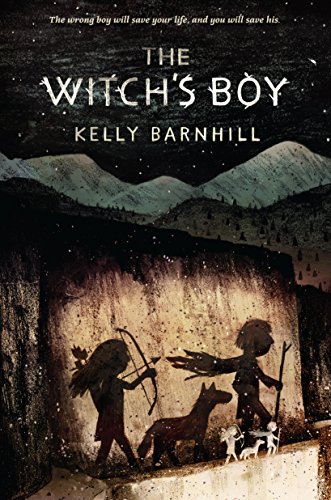
Algonquin Young Readers, 2014
A Washington Post Best Book of 2014
A Publishers Weekly Best Book of 2014
A Kirkus Reviews Best Children’s Book of 2014
A Chicago Public Library “Best of the Best” 2014

When Ned and his identical twin brother tumble from their raft into a raging river, only Ned survives. Villagers are convinced the wrong boy lived. Across the forest that borders Ned’s village, Áine, the daughter of the Bandit King, is haunted by her mother’s last words: “The wrong boy will save your life, and you will save his.” When the Bandit King comes to steal the magic Ned’s mother, a witch, is meant to protect, Áine and Ned meet. Can they trust each other long enough to cross a dangerous enchanted forest and stop the war about to boil over between their two kingdoms?
Kelly says…
I started this book by accident, while out on a long hike. My family had gone to Shenandoah National Park, and were hiking from the trailhead at the Skyline Drive down to an absolutely beautiful waterfall. The hike there, about three miles, was entirely downhill. My son, Leo, was six years old and a vibrating tangle of pent-up energy and perpetual motion and misbehavior. He ran the whole way there. Going back, though, was a different story. The trail was steep and rocky and hard. He wanted to be carried (there was no way). He wanted to grow wings. He wanted teleportation to exist. He wanted a lot of things. I just needed to keep him moving.
So I said, “Buddy, let’s play at stories.”
It was a game we played often. This is how it worked: he would give me three things – objects, situations or ideas – and I would turn them into a story. We did this most nights, back then, because it was the only way to get that whirlwind of a child to go to sleep.
So I said, “Give me three things.”
He thought about it. He thought for a long time. He kept hiking. I thought for a moment that he had forgotten the story all together, but he hadn’t. “I want you to tell me a story about a boy who steals his mother’s magic.”
Well then. Now we were getting somewhere. I nodded soberly. “Stealing magic is a good start,” I said. “Why would he steal his mother’s magic?”
Leo shrugged. “To protect it from bandits,” he said, as if it was obvious.
I took this in. “Okay,” I said. “I can work with that. But I need a third thing to start the story. What else should it have?”
Leo thought a moment longer. “A best friend who is a wolf,” he said. “But a little wolf. Like a kid. Like me.”
And with that we were off to the races. By the time we made it to the trail head, our hero Ned had been marked by magic, shoved into a sack, and lashed to the back of a horse, galloping straight into the most dangerous forest in the world. Leo and I blinked as we stepped out of the woods into the road.
He turned to me. “Is that the end?” he said.
I shrugged. “No, buddy,” I said. “I’m pretty sure it’s the beginning.”
And so we walked over to our cabin, and I wrote out the first five chapters of The Witch’s Boy.
Reviews:
“Barnhill weaves a powerful narrative about the small tragedies that happen when parents fail their children, even with the best intentions…Barnhill elegantly joins the story’s diverse threads in a complex tale whose poignancy never turns sentimental.
— Publishers Weekly, starred review
“This spellbinding fantasy begs for a cozy chair and several hours of uninterrupted reading time.”
— The Washington Post
“Barnhill is a fantasist on the order of Neil Gaiman.”
— Minneapolis Star Tribune
“[The Witch’s Boy] should open young readers’ eyes to something that is all around them in the very world we live in: the magic of words.”
— The New York Times
“This is a book to treasure.”
— Nerdy Book Club
